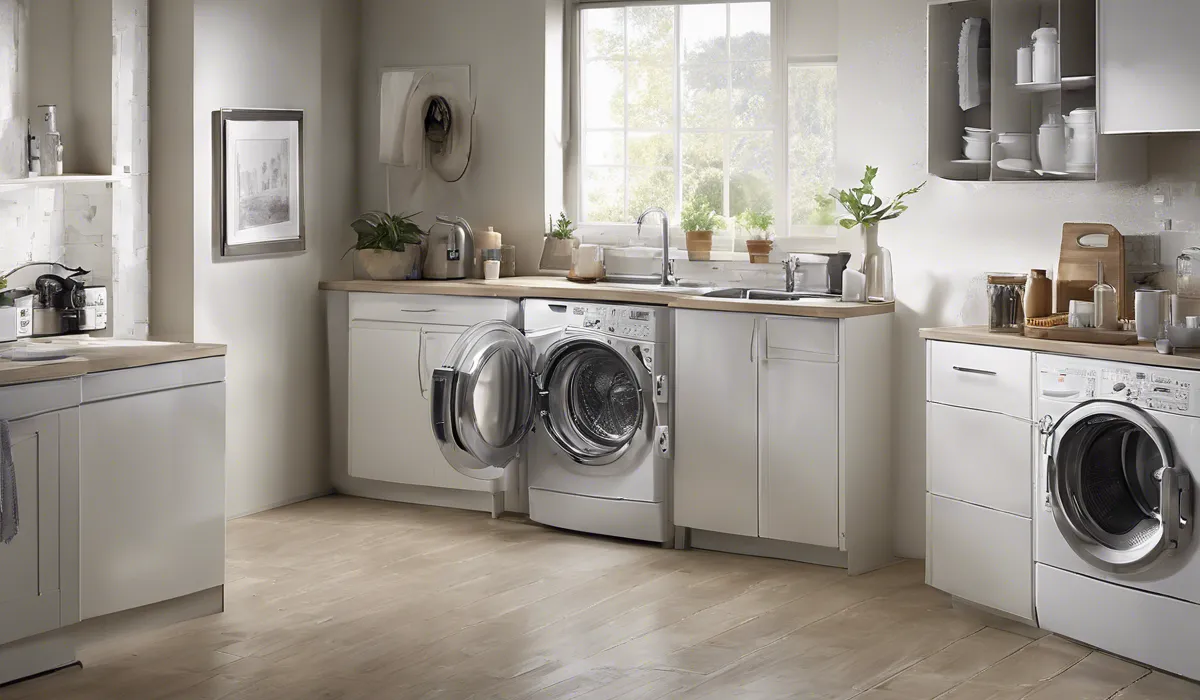Can Dishwasher Be Placed on Washing Machine? Know the Risks!
No, a dishwasher should not be placed on top of a washing machine. The vibration from the washer can damage the dishwasher, and it may be unstable, posing a safety risk. Always follow manufacturer guidelines for proper installation and placement.
Assessing Space and Infrastructure Requirements

Evaluating the Floor Plan and Available Space
Before considering placing a dishwasher on top of a washing machine, it is crucial to evaluate the floor plan and the space available in your home.
This involves measuring the area where you intend to put the appliances to ensure that there is enough room not only for installation but also for usage and maintenance.
It is important to have enough clearance for the dishwasher door to open fully and for you to move around comfortably while loading and unloading dishes.
Analyzing the Strength and Stability of the Washing Machine
Washing machines are designed to bear their weight and not the additional load of another appliance. Analyzing the strength and stability of your washing machine is crucial to avoid any accidents or damage.
Washing machines undergo significant vibration and movement during their operation, which can be detrimental to the structure and function of a dishwasher placed on top.
The risk of the dishwasher falling or the washing machine breaking due to excessive weight is high and should be taken seriously.
Considering the Weight and Dimensions of the Dishwasher
When integrating appliances, the weight and dimensions of the dishwasher must be considered. Dishwashers are hefty and require a stable, level surface to operate correctly.
Stacking a heavy dishwasher on an appliance like a washing machine, which is not designed to support additional weight, can lead to structural damage or operational failure.
It is imperative to adhere to the manufacturer’s specifications for proper installation and placement to ensure safety and functionality.
Examining Electrical and Plumbing Configurations
The electrical and plumbing configurations are vital factors in the installation process of a dishwasher. Dishwashers require their own electrical connection and plumbing hookups, such as water inlet and drainage.
Placing a dishwasher on top of a washing machine may complicate these configurations, making it difficult to connect to the necessary utilities while adhering to building codes and safety standards.
Proper planning and understanding of these configurations are essential to avoid water leaks, electrical hazards, and ensure efficient operation.
Understanding Installation Implications

Reviewing Manufacturer Guidelines for Both Appliances
Adherence to manufacturer guidelines is paramount when installing appliances. These guidelines provide critical information on the safe and proper placement of appliances, including weight limits, spacing requirements, and other safety precautions.
Ignoring these could void warranties, lead to malfunctions, or pose serious safety risks. It is always recommended to consult the user manuals or manufacturer’s website to ensure compliance with their specific installation instructions.
Discussing Potential Risks of Stacking Appliances
Stacking a dishwasher on a washing machine comes with potential risks that cannot be overlooked. The vibration and movement from the washing machine can damage the electronic and mechanical components of the dishwasher.
Additionally, the weight of the dishwasher could compromise the structural integrity of the washing machine underneath, potentially leading to breakdowns or unsafe conditions.
Such risks can result in costly repairs or the need to replace one or both appliances prematurely.
Exploring Alternative Stacking Kits or Shelving Units
If space is a constraint, one may consider alternative solutions such as stacking kits or shelving units that are designed to safely stack appliances.
These kits and units are engineered to handle the weight and reduce the transmission of vibrations between machines.
It is essential to choose accessories specifically made for the models of your washing machine and dishwasher to ensure they fit securely and maintain stability.
Addressing Vibration and Noise Concerns
Vibration and noise are significant concerns when operating heavy appliances, especially if they are not installed on a solid foundation.
It is important to address these concerns by ensuring that both the washing machine and the dishwasher are on a level surface and have all their feet firmly on the ground.
Anti-vibration pads may also be used to minimize the amount of noise and movement transmitted through the floor.
Properly securing and balancing appliances will lead to a quieter and more pleasant environment, as well as reduce the wear and tear on the machines.
Maintenance and Accessibility Considerations

Ensuring Easy Access for Loading and Unloading Dishes
Accessibility is key for the practical use of a dishwasher. You must ensure that there is ample space to load and unload dishes comfortably.
This means there should be no obstructions that make it difficult to open the dishwasher door fully or to reach inside.
Convenient access not only makes the task of loading and unloading dishes easier but can also prevent injury from awkward bending or stretching.
Facilitating Convenient Maintenance and Repair Access
Appliances require regular maintenance and occasional repairs, and accessibility is crucial for these activities. If a dishwasher is placed in a location that makes it hard to access for service, it can become a significant hassle.
It is important to plan for maintenance access, including enough space to move the appliance if needed, to ensure that service technicians can easily reach all necessary components without risking damage to the machine or your home.
Planning for Efficient Water and Energy Use
Efficient water and energy use are important for environmental sustainability and keeping utility bills low. When installing a dishwasher, consider the appliance’s proximity to the water heater to minimize heat loss during water transport.
Additionally, look for Energy Star-rated appliances that are designed to use less water and energy without sacrificing performance. Proper installation and regular maintenance will also contribute to the efficient operation of the dishwasher.
Adhering to Safety Standards and Best Practices
Adhering to safety standards and best practices is non-negotiable when installing appliances.
This means following local building codes, using a licensed professional for electrical and plumbing work, and ensuring that all installations are secure and stable.
Regularly checking for recalls or safety notices from the manufacturer can also prevent accidents. It is always recommended to prioritize safety over convenience when making decisions about appliance installation and placement.
FAQs About Placing Dishwasher on Washing Machine
Can a dishwasher be safely placed on top of a washing machine?
No, it is not safe to place a dishwasher on top of a washing machine due to potential damage and stability issues.
Will the vibration from the washing machine affect the dishwasher?
Yes, the vibration from the washing machine can damage the dishwasher over time.
Is there a risk of the dishwasher becoming unstable if placed on a washing machine?
Yes, placing a dishwasher on a washing machine can make it unstable, posing a safety risk.
Should manufacturer guidelines be followed for installing a dishwasher?
Absolutely, always follow the manufacturer’s guidelines for the proper installation and placement of a dishwasher.
Can any support accessories be used to place a dishwasher on a washing machine?
No support accessories are recommended for placing a dishwasher on a washing machine as it is generally unsafe and not advised by manufacturers.
Final Thoughts
Placing a dishwasher atop a washing machine is ill-advised due to potential damage from vibrations and inherent stability issues. This setup not only risks the functionality of the dishwasher but also presents a significant safety hazard.
Adherence to manufacturer’s installation guidelines is crucial for ensuring proper placement and operation of these appliances.





